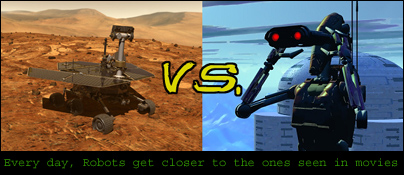By: Isaac Asimov
The Three Laws of Robotics:
Isaac Asimov changed our perception or robots forever when he formulated the classic laws governing their behavior. In 'I, Robot' Asimov chronicles the development of the robot from its primitive origins in the present to its ultimate perfection in the not-so-distant future - a future in which humanity itself may be rendered obsolete.
Here are stories of robots gone mad, mind-reading robots, robots with a sense of humor, robot politicians, and robots who secretly run the world, all told with the dramatic blend of science fact and science fiction that has become Asimov's trademark.
Asimov brought together several short stories about the relationships we have with robots. Before this book, we considered robots a threat to our existence. Asimov changed our views on robots by taking away their free will, thereby eliminating any threat that they might pose. Our ability to use robots is key in space exploration. There are three methods that we use to learn more about the Galaxy: telescopes, human exploration, and robotic spacecraft. Sending humans to a planet is a very expensive and difficult procedure, so we are fortunate to have the technology needed to send machines to conduct experiments for us. A majority of the recent discoveries are the result of robot exploration. For example, the rovers on Mars have given us a great deal of proof that Mars used to have liquid water. Future missions are being planned to explore under the ice of Jupiter's moon, Europa.
The robots in this novel are portrayed as almost-human in nature. Each robot is equipped with a positronic brain, which allowed them to have thoughts and emotions. Our current technology may not be that far along, but it is still remarkable how much our machines can do. Robotic spacecrafts are equipped with artificial intelligence, allowing them to perform tasks without having to wait for NASA to send commands. There are four different types of robots used for space exploration: the rover, probe, orbiter, and the flyby.

Flybys are the simplest type of robot that we can use. Basically, it will fly past an object, such as Saturn, and take several pictures of it. The flyby is most useful to us when it is able to pass by several planets during its trip. Not only will it be able to take close-up shots of the planets, but the gravitational pull from the worlds will slingshot the spacecraft through space. Fuel takes up a lot of space, so using gravity to propel a flyby is a very cost-effective method.
Some spacecraft are designed to get pulled in by a planet's gravity, and remain in orbit collecting data. These machines are called orbiters. Like the flyby model, orbiters take pictures of the surface of a planet. Since they remain within the planets orbit, they are able to capture pictures over a longer period of time. Orbiters can do more than just take pictures of the surface. The upcoming Mars Reconnaissance Orbiter will be able to test the spectroscopy of the surface, monitor the climate and cloud patters, and use radar to search for underground water. On a planet like Venus, where conditions are unbearable, an orbiter is the best way to learn more about the surface.
Probes are similar to orbiters, but they actually enter the atmosphere of the planet or moon to gather data. These robots are equipped with tools to find out about the weather, atmosphere, and many other environmental factors that we couldn't observe from space. Jovian Planets are mostly gaseous, so it is better to use a probe than a lander unit.
When we hear the word robot, we tend to think of the type of machine known as the lander. Landers do what their name implies; they land on the surface of a world and gather data. Spirit and Opportunity, the two rovers we've recently landed on Mars, and examples of landers. When a lander is being built, the scientists have to decide on what kinds of experiments it will carry out. The spacecraft can only be so big, and money is a factor. The two rovers on Mars were designed to see if there was ever liquid water on the surface. Several pieces of evidence have been discovered which strongly support this idea. The rovers noticed small, round stones about the size of a berry. Upon further examination, we discovered that these stones are made of Hematite, which forms only when there is water present. Future lander missions will be able to search for signs of life underneath the surface.
Perhaps the most realistic aspect of this book is the cost required to build a robot. When a dangerous Nestor model hid itself among similar robots, the scientists did not want to destroy such expensive pieces of machinery. To create a robot capable of performing a variety of tasks, it literally costs millions of dollars. This is why we try only send out one or two spacecraft at a time. Rather than building a small fleet of machines, each robot spacecraft is built to perform several tasks that all are designed with a specific goal in mind. The Mars rovers, for example, are searching for signs of liquid water. It also takes a very long time to build a robot. A scientist might spend ten years of their life working on one part of a spacecraft. It's no wonder why they get upset when a problem arises.